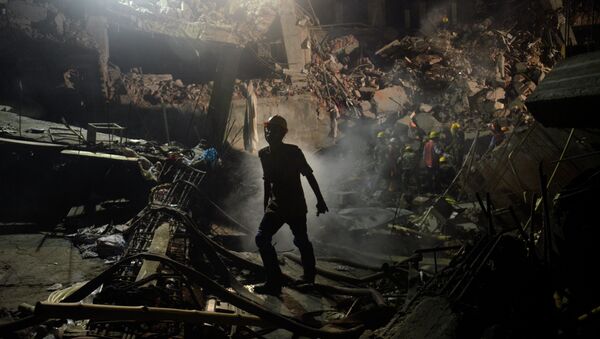The eight story commercial property named Rana Plaza collapsed with thousands of people trapped inside.
Grahame Lucas, managing director of Head of South Asia Service, Deutsche Welle, highlighted the conditions which resulted in the disaster:
Workers at the Rana Plaza complex first became alarmed when large cracks appeared in the building's walls. Staff left the building hastily after consultations with the management. But after a cursory inspection, supervisors dismissed their concerns and threatened wage cuts if the staff did not return to work the next day. The textile workers on some of the lowest wages in the world duly flocked back into the factory complex next morning for the start of the 8am shift. What they did not know was that the factory complex had been built in breach of construction regulations.
At 8:57am, during the morning rush hour, the building collapsed, leaving only the evacuated ground floor intact. The Bangladesh Garment Manufacturers and Exporters Association president stated that a total of 3,122 workers were inside at the time of the accident. The total number of deaths recorded after the rescue operation was 1,129. Apart from ignoring the warnings, these were the factors which led to the structural failure of the building: construction in unstable location without authorization, unauthorized addition of three floors beyond the permit, conversion of building’s permitted commercial use to industrial use and use of poor construction material. These factors highlighted the business practices by the construction company, factory owners and government, and served as a tell-tale sign of how business was done in Bangladesh in general.
Nobel Peace prize laueate Muhammad Yunus wrote in his column in The Guardian:
For Bangladeshis, the tragedy at the garment factory in Savar is a symbol of our failure as a nation. The crack that caused the collapse of the building has shown us that if we don't face up to the cracks in our own systems, we as a nation will get lost in the debris. Today, the souls of those who lost their lives in Rana Plaza are watching what we are doing and listening to what we say. The last breath of those souls surrounds us. Did we learn anything at all from this terrible loss of life? Or will we have completed our duty by merely expressing our deep sympathy?
This sort of corruption and negligence was considered to be murder when charges were filed against 42 people, including the owners of the collapsed building. Apart from sparking domestic debate on corrupt government, business practices and safety, the disaster also brought to light corporate social responsibility and international division of labor. Labor and human rights groups have criticized Western retailers, who profited from manufacturing in such conditions, and claimed they should be involved in ensuring safety and upholding rights in the factories used to produce goods they sell.

